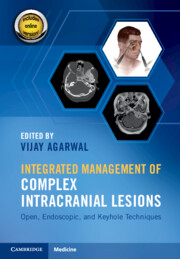Book contents
- Integrated Management of Complex Intracranial Lesions
- Integrated Management of Complex Intracranial Lesions
- Copyright page
- Dedication
- Contents
- Contributors
- Foreword
- Section I Endoscopic Endonasal (EN) Combined Approaches
- Chapter 1 Combined Endonasal Transethmoidal, Transcribriform, and Endoscope-Assisted Supraorbital Craniotomy
- Chapter 2 Combined Endonasal and Transorbital Approach
- Chapter 3 Combined Endonasal and Transoral Endoscopic Approach to the Craniovertebral Junction
- Chapter 4 Combined Endoscopic Endonasal and Transcervical Approach
- Chapter 5 Combined Endoscopic Endonasal and Transcranial Approach to Complex Intracranial Lesions
- Section II Open Combined Approaches
- Index
- References
Chapter 1 - Combined Endonasal Transethmoidal, Transcribriform, and Endoscope-Assisted Supraorbital Craniotomy
from Section I - Endoscopic Endonasal (EN) Combined Approaches
Published online by Cambridge University Press: 05 October 2021
- Integrated Management of Complex Intracranial Lesions
- Integrated Management of Complex Intracranial Lesions
- Copyright page
- Dedication
- Contents
- Contributors
- Foreword
- Section I Endoscopic Endonasal (EN) Combined Approaches
- Chapter 1 Combined Endonasal Transethmoidal, Transcribriform, and Endoscope-Assisted Supraorbital Craniotomy
- Chapter 2 Combined Endonasal and Transorbital Approach
- Chapter 3 Combined Endonasal and Transoral Endoscopic Approach to the Craniovertebral Junction
- Chapter 4 Combined Endoscopic Endonasal and Transcervical Approach
- Chapter 5 Combined Endoscopic Endonasal and Transcranial Approach to Complex Intracranial Lesions
- Section II Open Combined Approaches
- Index
- References
Summary
The combined endoscopic endonasal, transethmoidal, transcribriform approach with endoscope-assisted supraorbital craniotomy is a minimally invasive approach that can be used as an alternative to the classic transcranial, transfacial, or combined craniofacial approaches to lesions of the anterior cranial fossa. This approach is best used for lesions that extend anteriorly to the frontal sinus, laterally beyond the lamina papyracea, and inferiorly into the ethmoid sinus. This chapter details the approach as well as closure of the combined endoscopic endonasal, transethmoidal, transcribriform approach with endoscope-assisted supraorbital craniotomy.
Keywords
- Type
- Chapter
- Information
- Integrated Management of Complex Intracranial LesionsOpen, Endoscopic, and Keyhole Techniques, pp. 1 - 8Publisher: Cambridge University PressPrint publication year: 2021



